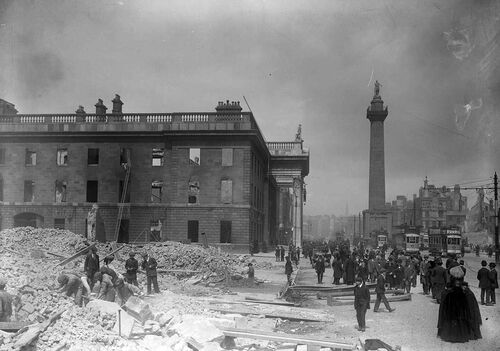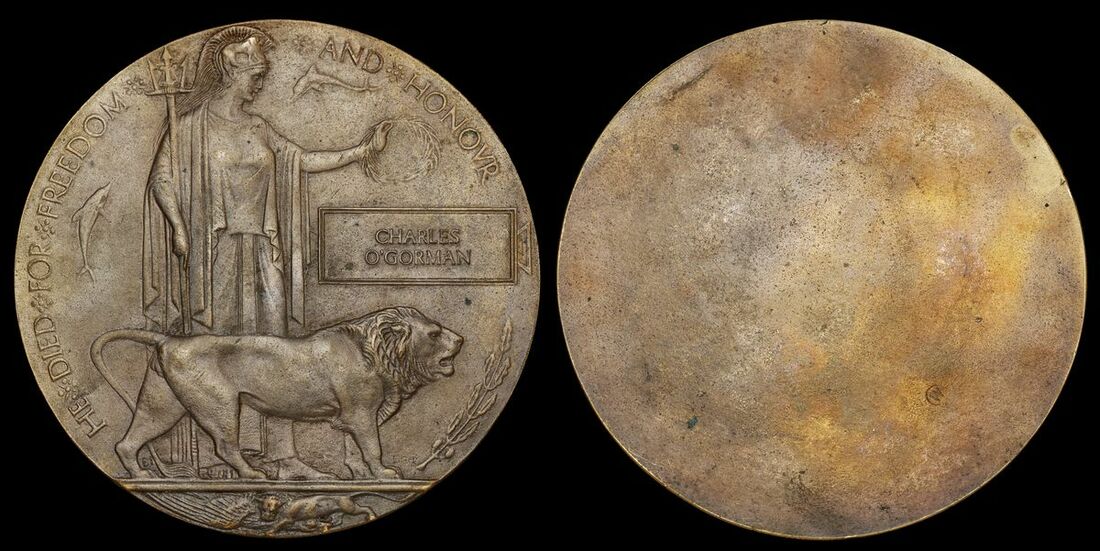Auction: 23002 - Orders, Decorations and Medals
Lot: 26
The emotive 'Easter Rising' Memorial Plaque awarded to Shoeing Smith C. O'Gorman, 10th Reserve Cavalry Regiment, a native Irishman from Limerick who was killed in action in Dublin on 24 April 1916
Great War Bronze Memorial Plaque (Charles O'Gorman), in card envelope of issue extremely fine
A unique name upon the Commonwealth War Graves Commission and this plaque represents the recipient's sole entitlement.
Charles O'Gorman was born at Merchant's Quay, Limerick, Ireland in 1894, the son of Patrick and Annie O'Gorman. After the death of his father the family moved into the house of his oldest sister in Pennywell who had recently married Matthew Sheedy, an engine driver. It is likely that Sheedy played a part in getting Charles in earliest employment as a locomotive brake fitter.
Charles left Limerick before the start of the Great War emigrating to England. Settling in London he was still there when war broke out, joining the 10th Reserve Regiment of Cavalry with the No. 13057. Here his metal working skills gave him the experience need to became a shoeing smith. This particular regiment was formed at the Curragh in August 1914 after the outbreak of war. Men who enlisted into the cavalry reserve were not usually posted to a cavalry regiment overseas, unless they were converted into infantry, or other corps before being sent there.
When the Easter Rebellion commenced on 24 April 1916- Easter Monday- the military authorities were quick to summon cavalry regiments from the Curragh and barracks nearest to Dublin city centre. There is a military record which states that the Reserve Cavalry was sent from Marlborough Barracks (now McKee Barracks) on Blackhorse Avenue to face the rebels in Sackville (O'Connell) Street. The rebels opened fire as the troops advanced down Sackville Street. As they passed Nelson's Pillar, outside the GPO, the rebels opened fire again from the GPO and surrounding buildings, killing three cavalrymen and injuring another. Charles O'Gorman was one of those killed along with his colleagues Private Herbert Cordwell and Sergeant Henry Shepherd all of whom lay dead on Sackville Street. Another man Lance Corporal Austin Walton was fatally wounded during the battle. As a result of the losses the remaining cavalrymen withdrew and returned to their barracks.
There is a separate account of how Charles O'Gorman met his death in the book According to their Lights by Neil Richardson. This account states that the Reserve Cavalry arrived, from the Curragh, in two trains on Easter Monday. They were dismounted and ready for combat. One train was sent, via a loop line, to the North Wall to guard the dock area. The remaining men were marched along the quays to City Hall, near Dublin Castle where they took part in the attack on the building. There was utter chaos with some of the soldiers firing on each other mistakenly thinking they were rebels. The attack was eventually suspended until the morning due to darkness descending and confusion over the strength of the rebel garrison. The building was easily taken the next morning and the remaining members of the garrison arrested. There were several casualties on both sides one of them being Charles O'Gorman. He was killed either in the street outside or the dark interior of City Hall the previous evening.
Regardless of which story is correct O'Gorman was killed on 24 April outside one of the most iconic scenes of the Rising, he is buried in Grangegorman Military Cemetery; sold together with a copied Commonwealth War Graves certificate and an extract from The Old Limerick Journal.
Subject to 20% VAT on Buyer’s Premium. For more information please view Terms and Conditions for Buyers.
Sold for
£2,700
Starting price
£2500







